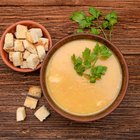
Especially in chilly weather, cream soups make a hearty starter course or sustaining main dish for a casual lunch or supper. The only challenge to preparing cream soups is the possibility of curdling of milk or cream. You can prepare other ingredients and then add milk or cream at the last minute. Otherwise, use one of several stabilizing techniques so that soup can be completed several hours ahead of serving time.
Preparing a Soup Base
For cream soups with either a meat or vegetable base, you can cook them in advance and add milk or cream shortly before serving. Cook the meat or vegetables and broth until soft and strain or puree right after cooking; you can now refrigerate your broth base for 1 to 2 days or freeze it until you want to make soup.
Cream and Curdling
Curdling, or the premature cooking and clotting of milk protein particles, happens most often when cold milk or cream is added to a hot soup base. To keep dairy products from separating, warm milk or cream to just under boiling, or approximately 190 degrees Fahrenheit, or warm the milk or cream with a technique called tempering. A small quantity -- a cup or so -- of hot soup base is stirred into a larger amount of milk or cream, then another cup of hot base is added to the mixture. At this point the warmed mixture can be added to the remaining base without serious danger of curdling or clotting. Tempered soup can be chilled for several hours and reheated at serving time. Do not let the soup boil during reheating.
Cream vs. Milk
There is a correlation between fat content and curdling; heavy cream is less likely to separate or curdle than whole milk or half and half. If you encounter repeated problems with a particular recipe, adding a higher-fat form of milk product may make your soup mixture more stable. You do not need to substitute heavy cream for all the milk in the recipe -- just enough to increase smooth incorporation.
Blending to Stabilize
For a smoothly mixed pureed soup, rely on thorough mechanical blending, either with a counter-top blender or an immersible type, just before soup is heated for serving. Thorough blending, rather than just mixing with a whisk or spoon, minimizes the chances of ingredients separating when served.
Stabilizing with Roux
Make a butter and flour roux to stabilize your soup. Melt one to two tablespoons of butter over low-medium heat and add an equal quantity of white flour, cooking the mixture for a couple of minutes to lessen the floury taste. Mixed with roux, the milk or cream for your soup becomes what beginning cooks recognize as thin white sauce, which will not curdle if soup is made ahead.
Sequencing Your Ingredients
Lessen the chances of curdling by adding acidic ingredients like lemon juice or diced tomato during the final heating just before you serve the soup. If acid ingredients must be added earlier, use the roux strategy before adding any dairy products to soup.
Completing Your Soup
Once the ingredients are combined, keep the soup warm in a double boiler or over very low heat until ready to serve. For a large quantity of soup, the low setting on your crock-pot or slow cooker can keep soup warm for a hour.
If you need to assemble soup more than an hour ahead, refrigerate it, covered, until it is time to heat it. If your recipe offers more specific directions on assembling and heating, follow them instead. While some soups may improve with overnight storage, less stable mixtures may tolerate only a very brief wait-time.
Last-Minute Preparations
With cream soups, as with all soups, it makes sense to taste and correct seasonings just before serving the soup. The flavors of certain herbs, spices, salt and pepper tend to intensify with prolonged waiting, while the taste of others fade.
Related Articles

Why Do Cream Soups Curdle and Turn Sour?

Do You Use Flour or Corn Starch to ...

How to Get Half & Half to Thicken

How to Make a Cream Soup Without ...

What Else Could You Use Besides Cream ...

Substitute for Heavy Whipping Cream in ...

Can You Thicken Soup With Xanthan Gum?

How to Cut the Acidity of Vegetable Soup

How to Cook Lipton Soup Secrets

How to Substitute Potato Starch for ...

What Can I Use to Thicken a Cream Sauce?

Can You Hold Mornay Sauce Overnight?

How to Mix Whipped Cream Cheese & ...

How to Use a Cream With Arginine

Cooking Yogurt Without Curdling It
Can I Cold Pack and Can Homemade Soup?

How to Add Noodles to Soup

How to Make French Sauce With Roux of ...

Can You Use Flour to Thicken Chili?

What Can I Use Instead of Cream of ...
References
Writer Bio
Janet Beal has written for various websites, covering a variety of topics, including gardening, home, child development and cultural issues. Her work has appeared on early childhood education and consumer education websites. She has a Bachelor of Arts in English from Harvard University and a Master of Science in early childhood education from the College of New Rochelle.
Photo Credits
Medioimages/Photodisc/Photodisc/Getty Images